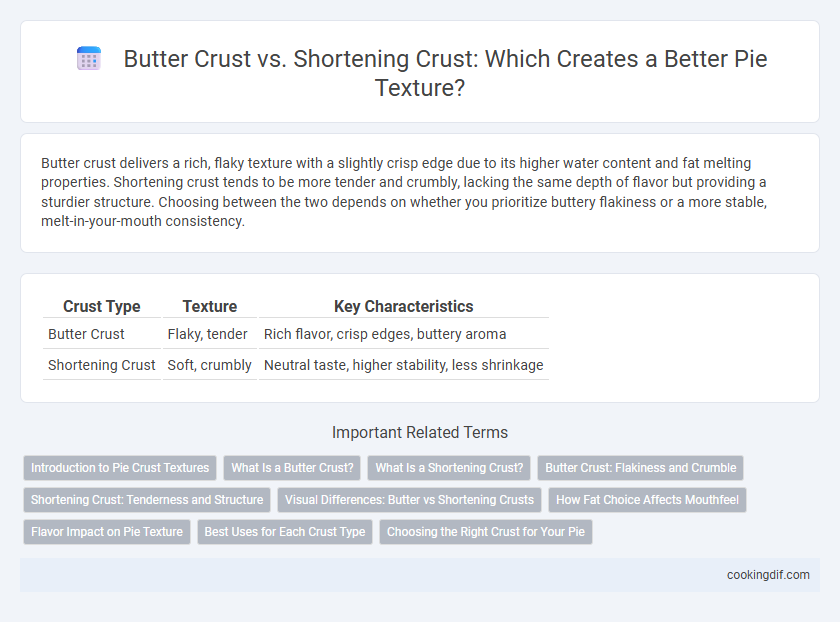Butter crust delivers a rich, flaky texture with a slightly crisp edge due to its higher water content and fat melting properties. Shortening crust tends to be more tender and crumbly, lacking the same depth of flavor but providing a sturdier structure. Choosing between the two depends on whether you prioritize buttery flakiness or a more stable, melt-in-your-mouth consistency.
Table of Comparison
| Crust Type | Texture | Key Characteristics |
|---|---|---|
| Butter Crust | Flaky, tender | Rich flavor, crisp edges, buttery aroma |
| Shortening Crust | Soft, crumbly | Neutral taste, higher stability, less shrinkage |
Introduction to Pie Crust Textures
Butter crusts create a flaky, rich texture due to the water content in butter turning to steam during baking, which helps form layers. Shortening crusts tend to produce a more tender, crumbly texture since shortening melts at a higher temperature and contains no water, resulting in less gluten development. Understanding these differences allows bakers to choose the ideal crust texture for their specific pie recipes.
What Is a Butter Crust?
A butter crust is made primarily from butter, which melts during baking to create a tender, flaky texture with rich flavor due to its high fat content and water composition. This type of crust achieves a golden color and crispiness as the butter's moisture steams and puffs the dough. Compared to shortening crusts, butter crusts offer superior taste but require careful handling to prevent the butter from melting too quickly and making the dough greasy.
What Is a Shortening Crust?
A shortening crust is a type of pie crust made using solid fats like vegetable shortening, which creates a tender and flaky texture by preventing the formation of gluten strands during mixing. Unlike butter crusts, shortening crusts have a higher melting point, resulting in a sturdier dough that is less prone to shrinking and is easier to handle. This characteristic makes shortening crusts ideal for pies requiring a crisp, stable base that holds fillings well without becoming soggy.
Butter Crust: Flakiness and Crumble
Butter crust creates a superior flakiness and crumble due to its high water content, which produces steam during baking, causing delicate, layered textures. The milk solids in butter contribute to a rich flavor and tender crumb, enhancing the overall eating experience. Unlike shortening crusts, which tend to be tender but denser, butter crusts offer a light, crisp bite with a buttery aroma that defines classic pastries.
Shortening Crust: Tenderness and Structure
Shortening crust offers superior tenderness and a flaky structure due to its high melting point, which prevents the fat from melting too quickly during baking. This characteristic creates well-defined layers, resulting in a crisp yet delicate texture. The use of shortening also enhances the dough's workability, making it easier to roll and shape without becoming greasy.
Visual Differences: Butter vs Shortening Crusts
Butter crusts showcase a golden, flaky texture with distinct, crisp layers due to the water content in butter creating steam during baking. Shortening crusts appear paler and more uniform, offering a tender, crumbly texture because shortening lacks water and melts evenly without steam pockets. Visually, butter crusts exhibit a richer color and more pronounced flakiness compared to the soft, matte finish of shortening crusts.
How Fat Choice Affects Mouthfeel
Butter crusts deliver a rich, flaky texture with a buttery mouthfeel due to the water content creating steam during baking, which forms delicate layers. Shortening crusts yield a tender, crumbly texture because the fat coats flour proteins more completely, inhibiting gluten formation for a softer bite. Choosing butter enhances flavor and flakiness, while shortening ensures consistent tenderness and less greasy residue.
Flavor Impact on Pie Texture
Butter crusts deliver a rich, tender texture with a distinct creamy flavor that enhances the overall pie experience. Shortening crusts create a flakier, more crumbly texture due to their higher melting point, but they lack the depth of flavor that butter provides. Choosing butter results in a flavorful, moist texture while shortening emphasizes crispness and structure without the buttery taste.
Best Uses for Each Crust Type
Butter crusts deliver a rich, flaky texture ideal for fruit pies and tarts where flavor enhances the filling. Shortening crusts offer a tender, crumbly texture best suited for cream pies and savory quiches, providing a sturdy base without added butter flavor. Choosing butter or shortening crust depends on the desired texture and flavor profile for the pie's filling.
Choosing the Right Crust for Your Pie
Butter crust offers a flaky, rich texture due to its higher water content and fat composition, creating distinct layers when baked. Shortening crust yields a tender, crumbly texture with less shrinkage, making it ideal for pies requiring a sturdier base. Selecting between butter and shortening depends on the desired balance of flavor and texture for your specific pie recipe.
Butter crust vs shortening crust for texture Infographic

 cookingdif.com
cookingdif.com